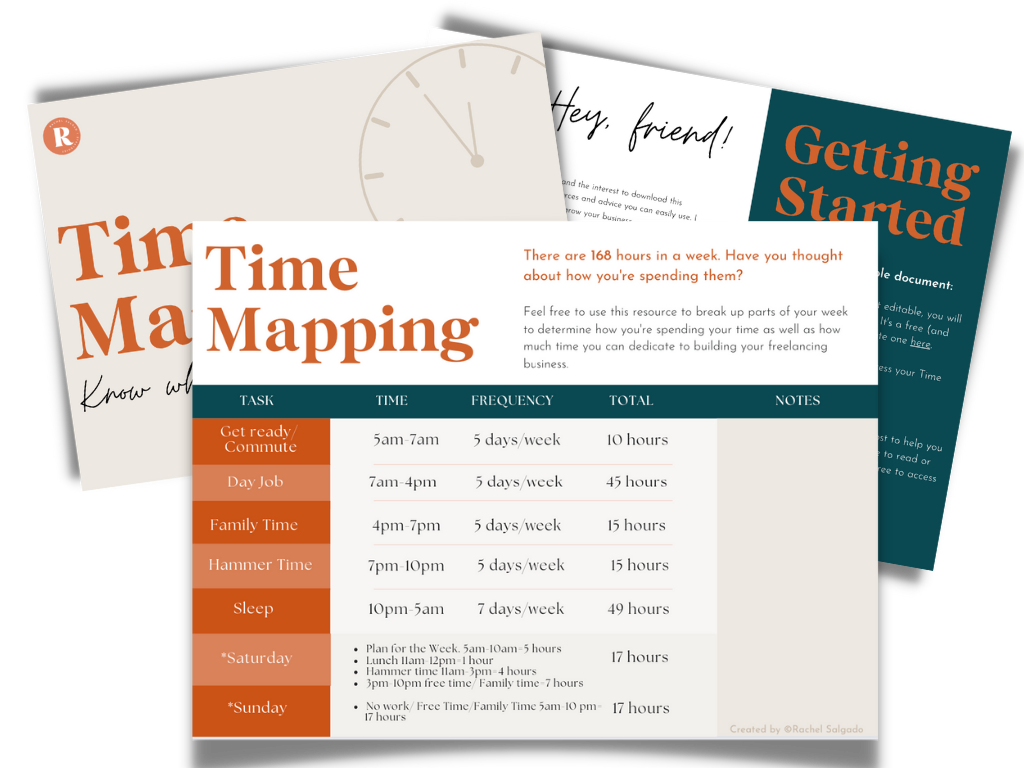How to Balance Freelancing with Your Day Job
I remember standing in my empty 4th grade classroom while my kids were in PE and thinking, "I'm not meant to work a traditional job."Can I be honest? I felt so ashamed to say this because teaching is rewarding and is considered a noble profession. BUT, it takes so much from you. But I knew that I needed to explore other options.
I think most of us freelancing rebel types go through a period of wonder. Wondering “Is this even possible?” Or “What will this look like?” And then, “How do I make this happen?” But working from home seems so far-fetched and elusive doesn't it? And you can't just quit, well most of us that is, so how do we transition?
How do we balance freelancing with the structure and benefits of a full-time job consistently? I'm not going to BS you here. It's not easy, but not in the way you might think. You see, some nights, you'll come home from a long day of work and be exhausted. And talking to someone or working on any type of project? Yeah, that doesn't quite jive with your mental bandwidth. What sounds better is a couple of episodes with David Rose or maybe rolling around on the floor with your kiddo.
So what gives? How can we balance our exhaustion from our 9-5 with excitement for building your freelancing business without becoming burnt out and straight up hating life.
Before we go on, I should acknowledge something too. The information I'm sharing in this post is what has worked for me personally. Any advice you see here, if it aligns with you, try to manipulate it to make it work for you. We all have different experiences and backgrounds. We all hold different privileges and what is easier for one, may not be as possible to access for another. And no one knows you better than you. So, do what feels good for you.
Today I'm going to share with you 5 things you can try to start or grow your freelancing business while also working full-time.
Step One: Determine How Much Time You Actually Have To Dedicate To Your Business
How much time do you have to dedicate each week to your business? I like to call mine Hammer Time, but you know, do you. Now I know that question is a vague and guessing will get is nowhere so let's get strategic here and actually break this down.
Oh, by the way, I don’t usually do math on public, but for you? Well, I’m throwing out the rule book for this one.
Calculating Your Time Through Time Mapping
Have you ever been busy doing “things” and you wonder where your day has gone? The information I’m about to share can be a resource/tool for you to help with that and make the time you spend each day more intentional.
There are 168 hours in a week. I’m going to create a mock schedule based on my teaching days as an example through something I like to call Time Mapping. Mapping out how your time is being spent has been an extremely helpful process for me so I hope this will be helpful for you as well!
Think this will work for you?
If you’d like to give Time Mapping a whirl, feel free to download this editable resource.
Monday-Friday
5am-7am Get Ready/Commute x 5= 10 Hours
7am-4pm at School x 5 days a week= 45 Hours
4pm-7pm Family Time x 5 days = 15 hours
7pm-10pm Hammer Time x 5 = 15 hours
10 pm-5 am 7 hours of Sleep x 7 days a week= 49 hours
Saturday
I like to track Saturday and Sunday separately since the schedules vary so dramatically. Notice that I did not track sleep these days, since I added sleep on the Monday-Friday schedule collectively. So when you look at this, just keep in mind that sleep isn’t added below.
5 am-10 am Plan for the Week/Grade Papers etc.= 5 Hours
10am-11am Lunch= 1 hour
11am-3pm Hammer Time= 4 hours
3pm-10pm Free Time/ Family Time= 7 hours
Sunday
No work/ Free Time/Family Time 5am-10pm= 17 hours
Total time to work on my business (aka Hammer Time) = 19 Hours Per Week
So you have you Hammer Time mapped, but do you really need to fill it all?
According to my “schedule”, I have 19 hours of time I can dedicate to my business that still allows me to have adequate rest, spend time with my family and catch up on work from my day job.
So with this schedule, I would do hammer time every day except Sunday to hit the 19 hour mark. Here’s something though that I would love for you to think about. Just because I HAVE 19 hours does it mean I need to DO 19 hours? The evidence is there, I’ve calculated the allotted time, but I’m literally at my max here. What if I cut it in half or close to half? I actually got the goal chop idea from the book Finish, by Jon Acuff (affiliate link). Highly, highly recommend.
Now, at this point you're probably thinking this is WTF advice, but hear me out.
By cutting it in half, I’m creating a bit of room for myself if something comes up or if I just need it to lay on the couch and binge Gilmore Girls. You want to try to make this sustainable. So instead of going all on, try half for the first month to adjust, and slowly add more when it feels right.
Now, I personally don’t love doing things everyday and would rather chunk it up. So if I implement cutting my goal I’m half, which would leave me with about 10 hours, it would free up some time during the week.
So create a schedule with built in, intentional time to devote to your business each week and see if that works for you.
Step 2: Get a Big Picture Strategy in Place
So now you’ve done this amazing job of creating this space, so what do you fill it with? Before we move on, I encourage you to think about this section as what you need to do to either start or grow your freelancing business.
Let's zoom out here a bit because there are a few things to consider:
Are you just starting fresh?
Do you have clients already?
If you’re new to the freelancing world, you’ll have a different approach than someone who has clients…sort of. Your focus will be to get your first client. So your goals will be built around that. This can look like, sending out proposals on Upwork, networking in FB groups, and learning how to position yourself to prospects.
If you have clients already, this looks a bit different. You have several things to take care of on a weekly basis like client work, client experience/communication, getting new clients if you plan to grow, creating systems, administrative work and so on. If you’re in this stage, you’ll need to think about how you want your business and life to look like in the next year 2 years. So if your goal is to work at home full-time, then your focus would be to maintain and acquire clients to get you there.
Think about your individual phase and create a realistic expectation around this. This is important because the next step is to create your goals.
Step 3: Creating Quarterly Goals
So when I create goals I like to think of them as quarterly periods (See below).
Quarter 1 is Jan-March
Quarter 2 is April-June
Quarter 3 is July-September
Quarter 4 is Oct-December
Why take this approach?
By blocking a timeframe to complete a needle-moving goal, you have a period to plan in and a deadline. So over the course of 3 months you should have hit a major milestone that will help you reach your big picture, like I mentioned previously.
Breaking down each quarter
So let's say I'm new to freelancing and my goal for this quarter is to sign 2 new clients.
Let's say we were in Q1, here's what this could look like
January- Develop mission, vision and values statement, determine a target market, Get clarity and map out offers, Sign up and create a Calendly account for clients to book a call with me, optimize social media profiles to attract and inform those clients, collect testimonials from past jobs, set up profile on Upwork and Freelancer.com, draft proposals, research, personalize and send a proposal to 25 clients per month, let friends and family know in on my business
February- Create a welcome packet, research and create a simple on-boarding system, buy a template on Squarespace to create a simple website, draft proposals, research, personalize and send a proposal to 10 clients per week
March- Do a training on my area of interest to sharpen my skillset, draft proposals, research, personalize and send a proposal to 10 clients per week, develop a strategy to get visible and become known for my expertise
You'll notice in this example, sending proposals to clients is at the core of each month, which aligns with the quarterly goal of signing two clients.
Now that we've got out monthly goals mapped out. We will want to now break those into weekly tasks.
Step 4: Map Out and Prioritize Your Weekly Tasks
So let's refer to January for this one. For reference, our January goals were as follows:
Develop mission, vision and values statements, Determine a target market, Get clarity and map out offers, optimize social media profiles to attract and inform those clients, collect testimonials from past jobs, set up profile on Upwork and Freelancer.com, draft proposals template, research, personalize and send a proposal to 10 clients per week, let friends and family know in on my business
For this you would break down each week into tasks and list them by priority. For example:
Week 1:
Develop mission, vision and values statements
Determine a target market
Get clarity and map out offers
Create profile on Upwork or Freelancer.com
Week 2:
Optimize social media profiles to attract and inform those clients
Sign up and create a Calendly account for clients to book a call with me
Draft proposals template
Collect testimonials from past jobs
Let friends and family know in on my business
Week 3:
Research, personalize and send a proposal to 12 clients per week
Week 4:
Research, personalize and send a proposal to 13 clients per week
If you notice in this example, since they are new to freelancing, manipulating the client outreach work was put towards the end of the month versus jumping right into it. This allows for a bit of breathing room while adjusting to the new schedule as well as the world of freelancing.
Of course from here, you would fill your allotted time that you determined in step one with the weekly tasks in this step.
Recap
Phew that was a lot. so let’s do a little recap. If you are transitioning from 9-5 or balancing freelancing with your day job can be tricky. Here are some tips mentioned in this blog post to help:
Determine How Much Time You Actually Have To Dedicate To Your Business
Get a Big Picture Strategy in Place
Create Quarterly Goals
Map Out and Prioritize Your Weekly Tasks
Resources Mentioned in this Post
Download your Time Map to get more clarity on how your time is spent.



